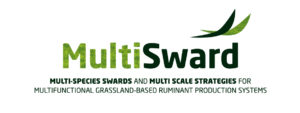Multisward project
 Multi-species swards and multi scale strategies for multifunctional grassland-based ruminant production systems
Multi-species swards and multi scale strategies for multifunctional grassland-based ruminant production systems
2010-2014
The objective of Multisward was to support developments and innovations in grassland use and management in different European farming systems (including low-input and organic), pedoclimatic and socio-economic conditions i) to enhance the role of grasslands at farm and landscape levels to produce environmental goods and to limit the erosion of biodiversity and ii) to optimise economic, agronomic and nutritional advantages for the development of innovative and sustainable ruminant production systems.
website : www.multisward.eu
Inno4Grass project
 Shared Innovation Space for Sustainable Productivity of Grasslands in Europe
Shared Innovation Space for Sustainable Productivity of Grasslands in Europe
2017-2020
Inno4Grass is an international and multi-actor project gathering prominent farmers‘ organizations, extension services, education and research institutions from eight EU countries – Germany, Belgium, France, Irleand, Italy, the Netherlands, Poland and Sweden, in which grasslands have a considerable share in the agricultural area and where production of dairy, beef and sheep is of major economic imprortance.
This project has received funding from the European Union’s Horizon 2020 research and innovation programme under grant agreement No 727368
website : inno4grass.eu
RMT Prairies Demain

Réseau Mixte Technologique “Prairies Demain”
2013-2018
![]() Labellisé en 2013 pour 5 ans, le RMT Prairies Demain se donne pour objectif de contribuer à mieux valoriser le potentiel productif et alimentaire de la prairie pour maintenir le maximum de surfaces en herbe, renforcer la place de l’herbe dans les systèmes d’élevage d’herbivores et améliorer l’efficience technico-économique de ces structures.
Labellisé en 2013 pour 5 ans, le RMT Prairies Demain se donne pour objectif de contribuer à mieux valoriser le potentiel productif et alimentaire de la prairie pour maintenir le maximum de surfaces en herbe, renforcer la place de l’herbe dans les systèmes d’élevage d’herbivores et améliorer l’efficience technico-économique de ces structures.
![]() Certified in 2013 for 5 years, the RMT Prairies Demain aims to contribute to better develop the productive and food potential of grassland to maintain the maximum of grass surfaces, strengthen the role of grass in livestock systems herbivores and improve the technical and economic efficiency of these structures.
Certified in 2013 for 5 years, the RMT Prairies Demain aims to contribute to better develop the productive and food potential of grassland to maintain the maximum of grass surfaces, strengthen the role of grass in livestock systems herbivores and improve the technical and economic efficiency of these structures.
Website : idele.fr